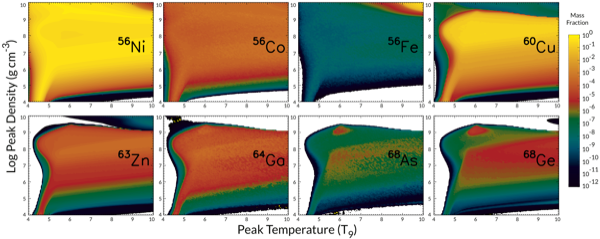
|
Cococubed.com
|
| Yields of Radionuclides |
Home
Astronomy research
Software Infrastructure:
MESA
FLASH-X
STARLIB
MESA-Web
starkiller-astro
My instruments
Neutrino Emission:
Neutrinos from de-excitation
Neutrino emission from stars
Identifying the Pre-SN
Neutrino HR diagram
Pre-SN Beta Processes
Pre-SN neutrinos
White dwarf pulsations:
12C(α,γ) & overshooting
Probe of 12C(α,γ)16O
Impact of 22Ne
Impact of ν cooling
Variable white dwarfs
MC reaction rates
Micronovae
Novae
White dwarf supernova:
Stable nickel production
Remnant metallicities
Colliding white dwarfs
Merging white dwarfs
Ignition conditions
Metallicity effects
Central density effects
Detonation density
Tracer particle burning
Subsonic burning fronts
Supersonic fronts
W7 profiles
Massive stars:
Pop III with HST/JWST
Rotating progenitors
3D evolution to collapse
MC reaction rates
Pre-SN variations
Massive star supernova:
Yields of radionuclides
26Al & 60Fe
44Ti, 60Co & 56Ni
SN 1987A light curve
Constraints on Ni/Fe
An r-process
Effects of 12C +12C
Neutron Stars and Black Holes:
Black Hole spectrum
Mass Gap with LVK
Compact object IMF
He burn neutron stars
Stars:
Hypatia catalog
SAGB stars
Nugrid Yields I
He shell convection
BBFH at 40 years
γ-rays within 100 Mpc
Iron Pseudocarbynes
Pre-Solar Grains:
C-rich presolar grains
SiC Type U/C grains
Grains from massive stars
Placing the Sun
SiC Presolar grains
Chemical Evolution:
Radionuclides in 2020s
Zone models H to Zn
Mixing ejecta
Thermodynamics, Opacities & Networks
Radiative Opacity
Skye EOS
Helm EOS
Five EOSs
Equations of State
12C(α,γ)16O Rate
Proton-rich NSE
Reaction networks
Bayesian reaction rates
Verification Problems:
Validating an astro code
Su-Olson
Cog8
Mader
RMTV
Sedov
Noh
Software Instruments
AAS Journals
2025 AAS YouTube
2025 Listing of 500+ Author Videos
2025 AAS Peer Review Workshops
2025 ASU Energy in Everyday Life
2025 MESA Classroom
Other Stuff:
Bicycle Adventures
Illustrations
Presentations
Contact: F.X.Timmes
my one page vitae,
full vitae,
research statement, and
teaching statement.
In this article, we explore the nucleosynthesis trends from freeze-out expansions in core-collapse supernovae. Our results suggest that isotopes in the mass range 12 ≤ A ≤ 122 that are produced during the freeze-out expansions may be classified in two families. The isotopes of the first family manifest a common mass fraction evolutionary profile, whose specific shape per isotope depends on the characteristic transition between two equilibrium states (equilibrium state transition) during each type of freeze-out expansion. The first family includes the majority of isotopes in this mass range. The second family is limited to magic nuclei and isotopes in their locality, which do not sustain any transition, become nuclear flow hubs, and dominate the final composition.
We use exponential and power-law adiabatic profiles to identify dynamic large-scale and small-scale equilibrium patterns among nuclear reactions. A reaction rate sensitivity study identifies those reactions that are crucial to the synthesis of radioactivities in the mass range of interest. In addition, we introduce non-monotonic parameterized profiles to probe the impact of the reverse shock and multi-dimensional explosion asymmetries on nucleosynthesis. Cases are shown in which the non-monotonic profiles favor the production of radioactivities. Non-monotonic freeze-out profiles involve longer non-equilibrium nucleosynthesis intervals compared with the exponential and power-law profiles, resulting in mass fraction trends and yield distributions that may not be achieved by the monotonic freeze-out profiles.

|
 |

Second family near magic number 28 |
|